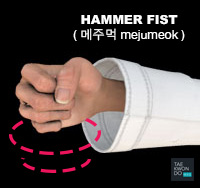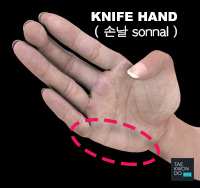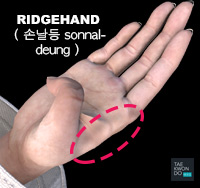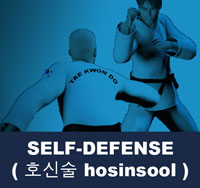Taekwondo 태권도Taekwondo Preschool
Promotion from one geup to the next can proceed rapidly in some schools, since schools often allow geup promotions every two, three, or four months. Students of geup rank learn the most basic techniques first, and then move on to more advanced techniques as they approach first dan. Many of the older and more traditional schools often take longer to allow students to test for higher ranks than newer, more contemporary schools, as they may not have the required testing intervals. View Taekwondo belt levels »

Jung Do Kwan 정도관
The original Taekwondo Kwans. In Korean literally means building or hall, but when used in martial arts it can also refer to a school or clan of martial artists who follow the same style and/or leader.
Jung Do Kwan 정도관 was founded in 1956 by Young Woo Lee, and was the last of the original nine Kwans that formed the Kukkiwon. This is detailed in "A Modern History of Taekwondo" by Kyong Myong Lee and Kang Won Sik (1999).
An original student of the Chung Do Kwan, Young Woo Lee was advised by the current Chung Do Kwan president to choose a similar name to Chung Do Kwan, so he chose Jung Do Kwan.
Young Woo Lee died in August 2006 in Seoul, Korea. Until his death, he remained active in the World Taekwondo Federation (WTF) which was renamed in 2017 to World Taekwondo (WT)  , and served on the Dan/Poom black Belt promotion committee of the Kukkiwon.
, and served on the Dan/Poom black Belt promotion committee of the Kukkiwon.
Taekwondo Jung Do Kwan still exists today, but only as a fraternal social friendship club. The official training curriculum endorsed by Taekwondo Jung Do Kwan is the Kukkiwon curriculum.
The word jung can be translated as righteous while do means way. So Jung Do Kwan can be translated as school of the righteous way.

Highlight World Taekwondo (WT) Tournament Point System
Under World Taekwondo (WT) and Olympic rules, sparring ( 겨루기 gyeorugi ) is a full-contact event and takes place between two competitors in an area measuring 8 meters square. Points are awarded for permitted, accurate, and powerful techniques to the legal scoring areas; light contact does not score any points. The only techniques allowed are kicks ( 차기 chagi ) (delivering a strike using an area of the foot below the ankle) and punches ( 지르기 jireugi ) (delivering a strike using the closed fist). The referee can give penalties at any time for rule-breaking, such as hitting an area not recognized as a target, usually the legs or groin ( 샅 sat ). View Tournament Point System »
* Please see a certified Master Instructor ( 사범님 sabeomnim ) for training. Proper guidance and instructions are needed to ensure safe training.

Original Taekwondo Kwans ( 관 )
In Korean, kwan ( 관 ) literally means building or hall, but when used in martial arts it can also refer to a school or clan of martial artists who follow the same style and/or leader. On January 8, 1977, nine of the largest kwans unified, recognizing the Kukkiwon 국기원 as being the black belt promotional body for taekwondo. Prior to this declaration, many practitioners had considered their individual kwan certifications as being more valuable than the certificates which were issued by the Kukkiwon 국기원 or Korea Taekwondo Association (KTA). For more information View Taekwondo Kwans ( 관 ) »
There are five tenets defined in the International Taekwondo Federation (ITF) and several more in World Taekwondo (WT).
Courtesy ( 예의 ye-ui ): "Showing courtesy to all, respecting others, having manners as well as maintaining the appropriate etiquette at all times, both within and outside the dojang (도장) (designated training area)." View Taekwondo Tenets »
RESOURCES
This article uses material from the Wikipedia article "Jung Do Kwan", which is released under the Creative Commons Attribution-Share-Alike License 3.0.





























